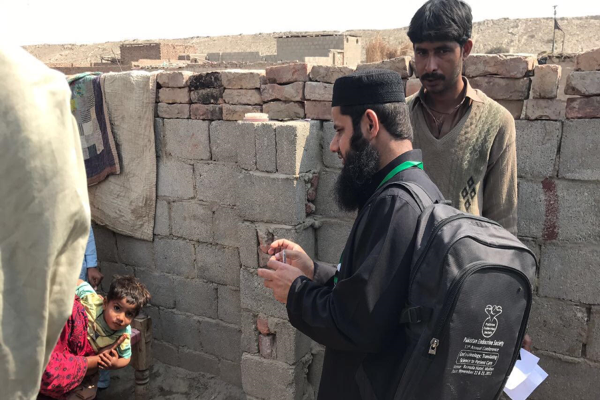Antibiotic Resistance and Poor Sanitation Making Typhoid Almost Untreatable in Pakistan

Investigators from Aga Khan University looking into the typhoid outbreak in Pakistan. Image courtesy: Coalition Against Typhoid
In Pakistan today, more and more cases of an almost untreatable kind of typhoid are being reported. This typhoid has been labelled as extensively drug resistant, or XDR. Five different kind of antibiotics fail in treating it, with only one strong antibiotic, azithromycin, able to combat it. But as this drug resistant typhoid spreads, largely through contaminated food and water, researchers fear that this antibiotic too might start to fail soon, leaving only expensive intravenous drugs (IV) as a treatment option. The availability of this treatment, like a clean water supply, will be restricted to the select few who can afford it.
Typhoid is caused by the bacteria Salmonella typhi, which affects up to 22 million people every year. If untreated, it can turn fatal. The bacteria had become resistant to multiple drugs in the past couple of decades, but it is only in the last two years that it developed resistance to an extent which has not been seen before in any disease outbreak.
A team of researchers from Pakistan’s Aga Khan University and Wellcome Sanger Institute of Britain found that the bacteria became XDR because H58, a strain of S. typhi which was already drug-resistant, acquired additional DNA which increased its resistance to even more kinds of drugs. While the previous resistance developed due to overprescription and misuse of antibiotics, this additional DNA came from E. coli, a bacteria commonly found in human faecal matter. According to the team, S. typhi would have mutated to its current form in the sewage pipelines of Pakistan, reaching people with this sewage seeping into the often contaminated water supply.
Today, this XDR typhoid is threatening to become an epidemic, like its previous, tamer form. In the past six months alone, more than 2000 people have been infected, according to Islamabad’s National Institute of Health. The spread is not limited to the population of the country. Cases have been recorded of people traveling to Pakistan and bringing back the infection with them, resulting in travel advisories being issued by health officials in US.
Elizabeth Klemm, one of the researchers in the team, said, “Increasing drug resistance means we have fewer drugs available to effectively treat the infection.” It could mean that treatment of typhoid might go back by 70 years, when no proper cures had been developed, and survival was a matter of luck.
With this, the focus is now on prevention rather than cure. In the beginning of this year, vaccination campaigns started in the city of Hyderabad after the approval of a new vaccine for XDR typhoid by the World Health Organization. But the administration of these vaccines has been fraught with challenges. Scientific American reports that people are often suspicious of the vaccinations because of widespread rumours about them being a “foreign plot to poison Pakistan’s children.”
The vaccination drives would have to be much faster and efficient if any hope of restricting the spread of XDR typhoid is to remain. More so since the other preventive measure, a supply of clean water to all households, also remains a distant dream.
Pakistan has grappled with ensuring sanitation facilities since a long time. It is an issue often brought up by international organisations, as well as politicians during election campaigns. But the challenges pertaining to this are also complicated.
In Lahore for instance, residents of Joseph Colony (most of whom are sanitary workers themselves ironically), say that rusty pipelines are a major cause of water contamination. These pipelines were installed almost four decades ago, and also contain high amounts of human waste according to microbiology reports of the water. The residents of this largely Christian society also allege that it is their religious marginalisation which is the reason for the delay in servicing of the water supply lines. The workers are forced to shell out Rs. 3,000 a month for accessing clean water.
The issue is not limited to just typhoid. Antibiotic resistance is a growing healthcare menace which is making treatment of many diseases increasingly difficult. When these drugs are either frequently prescribed, or taken via self-medication, they lead to the disease causing bacteria adapting and changing, and thus growing resistant. According to WHO, this is a “global health emergency.” Its solution cannot be found in development of new kinds of antibiotics alone, but also needs to deal with the prescription and misuse of antibiotics.
India, much like Pakistan, is also host to the combined problem of antibiotic overuse and poor sanitation. This makes the country “a perfect system for the spread of antibiotic resistance,” according to David Livermore, medical microbiology professor at the University of East Anglia.
The XDR typhoid strain is now found in one out of every three patients being tested for the disease in Pakistan. If urgent measures are not taken, the bacteria is likely to spill outside the borders, and the environment in India is welcoming.
Get the latest reports & analysis with people's perspective on Protests, movements & deep analytical videos, discussions of the current affairs in your Telegram app. Subscribe to NewsClick's Telegram channel & get Real-Time updates on stories, as they get published on our website.
























